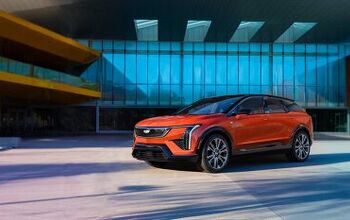Updated Bargain Basement EV Lands in Europe With Extra Range

While Hyundai’s compact Ioniq hatchback is most commonly seen in hybrid and plug-in hybrid guise, there’s also an all-electric model that took its sweet time breaking out of California. It’s notable not for its range (which, at 124 miles, puts it on par with also-ran EVs like the Volkswagen e-Golf), but for its price, which undercuts even the Nissan Leaf.
Hyundai unveiled an updated crop of Ioniqs back early this year, relegating the news to the more EV-friendly European market, but with the model line also on sale here its eventual arrival is a given. The biggest news to come from the reveal? A significantly larger battery for the Ioniq Electric.
Now that details are flowing on the imminently available 2020 Ioniq from overseas, we’re able to guess the model’s range.
According to Autocar, the switch from a 28 kWh battery to a 38.3 kWh unit earns the car a 36-percent improvement in driving range. Going by Europe’s WLTP cycle, that means 182 miles. On this side of the pond, simple math tells us that a 36-percent boost in range equates to 168 or 169 miles. That catapults the Ioniq EV’s range above that of the entry-level Leaf, which boasts 151 miles (moving up to the Leaf Plus earns you 226 miles, something Hyundai can’t offer unless you spend significantly more for a Kona EV).
Still, we await the EPA’s findings. Torque remains untouched at 218 horsepower while horsepower jumps from 118 to 134 hp, and charging speed gets a boost through a newly upgraded charger (7.2 kW versus the previous version’s 6.6 kW).
A price bump accompanies the added capacity, though where the model’s price will end up here remains unknown. A 2019 base Ioniq EV goes for $31,245 before a federal tax credit, of which Hyundai still has a generous stockpile. Moving up to the better-appointed Limited model will cost you an extra $5,500.
That’s assuming, of course, that you live in one of the 10 tree-hugging states where Hyundai actually sells the thing. Your author actually sees a couple of these budget EVs shuttling around on a regular basis. Less change is in store for the PHEV variant, though Autocar suggests an extra mile or two of range might be forthcoming. Currently, the Ioniq Plug-in rates an all-electric range of 29 miles and a starting price of $26,280 after destination.
Elsewhere, the model line dons new standard tech and safety equipment, plus a revamped front fascia and lighting.
While the Europeans can get their hands on the 2020 Ioniq fairly soon, North American customers remain in stay-tuned mode. In May, Hyundai said details would be forthcoming in the fall.
[Image: Hyundai]

More by Steph Willems
Latest Car Reviews
Read moreLatest Product Reviews
Read moreRecent Comments
- SCE to AUX Introduce a modern V-16 and put it into a Celestiq-like vehicle instead of electric.
- DungBeetle62 For where we're at in the product cycle, I think there are bigger changes afoot. With this generation debuting in 2018, and the Avalon gone, is the next ES to be Crown based? That'll be an interesting aesthetic leap.
- Philip Precht When Cadillac stopped building luxury cars, with luxury looks, that is when they started their downward spiral. Now, they just look like Chevrolet knock-offs, not much luxury, no luxurious looks. Interiors are just generic. Nothing what they used to look like. Why should someone spend $80,000 on a Cadillac when they can spend a LOT less and get a comparable looking Chevrolet????
- Ajla A time machine.
- 28-Cars-Later This question has been posed many times and we discussed it in depth around the time of the ATS and JdN. Then GM had 933 dealers left over from its glory days and ATS was intended to be volume lease fodder for all of those dealer customers. But of course the problem there is channel stuffed junk worked against the image they ostensibly were trying to create when they threatened products like Escala (and the image they thought they were creating with ELR). Cadillac had two choices in my view at the time, either drop 2/3rds of the dealers and focus on truly bespoke low volume product or abandon the pretense of exclusive/bespoke and build high volume models as they had essentially been doing since the last 1960s. Ten years on the choice they made was obvious, hence XT everything... XT an acronym for Xerox This when pointing at Chevrolets and Buicks.There's no "saving" a marque which doesn't wish to be saved. In the next major financial crisis Buick may be folded or consolidated into Chevrolet but Cadiwrack will just become a wrapper over whatever Chinesium infused junk the new openly owner/controlled SAIC GM wants it to be. Cadillac been gone for a long, long time.


































Comments
Join the conversation
Poor availability of the Kona EV was one reason we didn't pursue it harder. (The other was packaging; it has less room inside than the considerably smaller Bolt.) Edit: This was supposed to be a reply to SCE to AUX.
The availability is a legit concern. This is why all of my EV shopping leads back to Tesla.